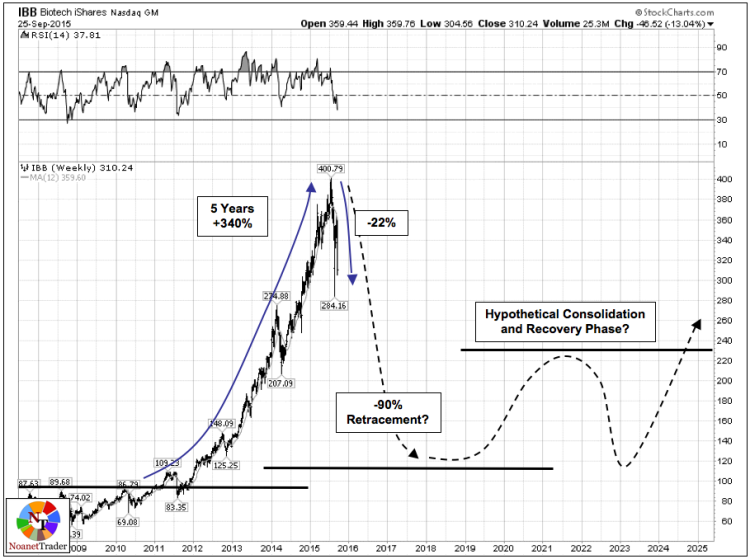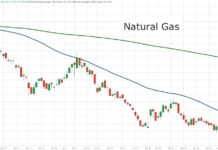As horrendous as the 80% drop in the Nasdaq Composite index may have seemed, investors who held an index-tracking fund or ETF at least recovered their losses despite having to wait a very long time.
On the other hand, holders of individual stocks of this era were not so lucky: hundreds of dot-com companies that were public in 2000 went out of business in the aftermath and their stocks went to zero.
Interestingly, Nasdaq’s return to new highs in 2015 was made possible by companies that did not even exist in 2000 (i.e. Google, Facebook, Twitter, etc.).
Blowing Market Bubbles… Is The Biotech Bubble Bursting?
Looking at the long-term price structure of the biotech sector, so far the obvious and glaring similarity is the run-up to the top. Much like the Nasdaq in late nineties, the biotech sector had an incredible five-year advance during which it more than quadrupled in value, see chart below.
In the last couple of years we have also seen many biotech startups with no revenue go public and get incredible billion-dollar valuations.
As mentioned above, current price action is consistent with a major top. The sector seems to have lost the upward momentum and, in my opinion, this makes it unlikely that we will see it stabilize in the short-term and head back up to new highs.
From this point on we can only try to speculate and make educated guesses about what the future holds for this sector.
Should the biotech sector follow a similar trajectory to the Nasdaq in 2000s, over the next several years we will see a significant retracement that could see the biotech index relinquish the majority of its recent gains and will similarly result in scores of currently public biotech companies disappearing forever.
Additionally, and since market bubbles take years to unwind, the biotech sector will likely see years of consolidation before it can finally be in a position to return to its all-time highs.
Conclusion
No two tops or market bubbles are the same. History never repeats itself exactly, but there will always be themes that rhyme from one market cycle to the next.
Despite the many similarities between the Nasdaq of 2000 and the biotechs now, it remains impossible to predict what the future has in store for this sector.
Certain themes, however, are likely to repeat themselves with this and other market bubbles:
- Big Run Ups Lead to Big Declines – Not that dissimilar from Newton’s Third Law of Motion, the one about action/reaction. Any time a stock or index quadruples (or more) in a relatively short period of time, the odds are the ultimate market top will lead to an equally severe decline
- Many Will Not Survive – Once the capital that fuels a bubble dries up, companies with weaker capital structure will disappear. The lucky ones will get acquired for the fraction of their IPO price, many will simply go bankrupt
- New Leaders Will Emerge – Over time new companies will rise from the wreckage of the bubble and put in the foundation for the eventual recovery
- Full Recovery Takes Time – The above process requires an inordinate amount of time that can be measured in decades
Thanks for reading and have a great week.
Twitter: @NoanetTrader
Author or his clients may hold positions in mentioned securities. Any opinions expressed herein are solely those of the author, and do not in any way represent the views or opinions of any other person or entity.








